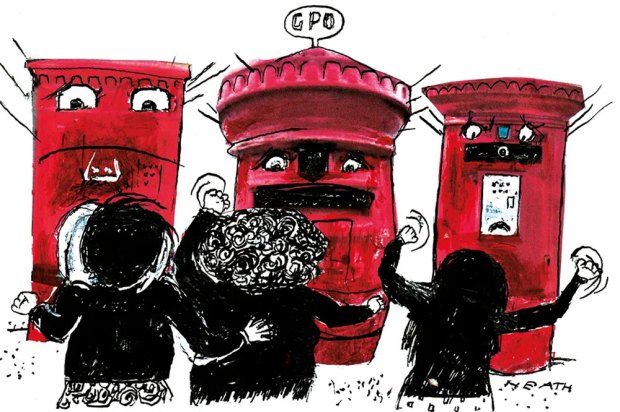Oxford Street is ‘a dinosaur district destined for extinction’, says Marks & Spencer boss Stuart Machin – whose plan to replace its ‘flagship’ Marble Arch store with a new ten-storey retail and office block has been referred to a public inquiry by Michael Gove as Housing Secretary, despite winning approval from Westminster council.
Machin points out that his real flagship nowadays is M&S’s website, which accounts for a third of the group’s clothing and home sales, while much of its pre-second-world-war store estate stands in sad need of repurposing or right-sizing. And he’s not wrong about the decline of what used to be Britain’s premier shopping boulevard – with its boarded-up Debenhams, its miasma of diesel and its horrible Americanised ‘candy stores’.
But John Lewis and Selfridges still count as destination stores, the latter especially for Chinese and Middle Eastern shoppers when they’re in town. And streets don’t actually die, they just become shabbier, less prosperous and more dangerous, as was already happening to so many British town centres in the ‘bloodbath’ of chain-store closures that preceded the pandemic and the current price shock.
So something should be done to make Oxford Street a model for the rest of the country, with the opening of the Elizabeth Line as a catalyst and imaginative regeneration schemes conceived in previous downturns – King’s Cross, for example – as models. Here’s a quick sketch of a plan: pedestrianise wherever possible, allowing only the most essential all-electric traffic; spotlight handsome older buildings and knock down nasty modern ones, replacing them with affordable flats and flexible workspaces; put stylish cafés on the pavements, public gardens on the rooftops and an Antony Gormley sculpture in the middle of Oxford Circus; plant lots more trees. Then rename the stretch between the new Tottenham Court Road and Bond Street stations ‘Elizabeth Avenue’.
Is Putin chuckling?
What happens when Russia defaults on its foreign debts? The deadline has just passed for $100 million of overdue interest payments – unpaid because sanctions exclude Russia from global payments systems, even though it has ample foreign currency in hand from oil and gas sales to Germany and elsewhere. Vladimir Putin’s proposal to make debt payments in roubles having been rejected, this is arguably a problem thrust upon international investors by western allies, and the US in particular, rather than by Russia itself.
Though widely expected by specialist bond investors, the default will add to the general nerviness of markets. A previous Russian default in 1998 led among other knock-ons to the collapse of a high-profile US hedge fund called Long-Term Capital Management and a major intervention by the US Federal Reserve. Even if nothing on that scale follows this one, Russia won’t be able to borrow again internationally until long after Putin has fallen. But how he must be chuckling, in his mad isolation, to see the economic harm he has wrought on his own benighted people being matched by the chaos he’s causing in the West.
Go-faster EVs
I’m a big fan of the Fiat 500 – because it has the retro charm of a design that dates from 1957, because it whizzes round corners like a motorised billiard ball and because it’s usually the cheapest hire car at provincial French airports. So my eye was caught by news that from 1 July, UK dealerships will sell only fully electric or hybrid versions of the entire Fiat range, including the 500 and the equally cute 4×4 Panda.
It’s impressive how Fiat has accelerated electrification, now due to be fully achieved in Europe by 2027. The whole auto industry’s rapid pivot to EVs – when five years ago it looked stubbornly set to carry on producing gas-guzzlers – is a textbook example of capitalism’s ability to adapt to market pressure, in which the current fuel price spike is a potent factor.
But UK government policies to support that pivot, by contrast, are a textbook example of virtue-signalling talk with inadequate substance: the ‘plug-in car grant’, designed to incentivise hesitant EV buyers, was scaled back repeatedly before being finally abolished last month, while shortage of charging points remains a huge disincentive; the majority of EVs in the UK are bought as company cars, for tax breaks, rather than by private citizens. The former GQ motoring columnist who clings on as our prime minister might be better employed injecting new fizz into the electric-driving revolution by letting his blond mop blow in TV adverts for a roof-down Fiat 500 Cabrio.
Hot prospect
As thoughts turn to next week’s closing date for our Economic Innovator of the Year Awards and the enjoyable task of selecting finalists, here’s news of a comparable scheme run by HM Treasury, which dishes out equity investment, rather than prize certificates, to a similar stratum of entrepreneur-led businesses. The Future Fund, set up to support UK companies facing pandemic problems, has converted more than 300 of its loans into share stakes, creating a random venture capital portfolio from football clubs to airships that taxpayers never expected to own. It even includes a holding in Killing Kittens, a ‘sex party organiser’ with 180,000 members and plans for overseas expansion.
Might Killing Kittens also be a suitable entrant for The Spectator’s awards? Its appeal to modern women makes it an innovator of sorts, even if its business model was developed in ancient Rome. As to ‘sustainability’, founder Emma Sayle might point out that you don’t need carbon-fuelled heating when you’re having an orgy. I hope she’ll have time, between arranging soft furnishings for this weekend’s events, to fill the entry form at www.spectator/innovator.
Got something to add? Join the discussion and comment below.
Get 10 issues for just $10
Subscribe to The Spectator Australia today for the next 10 magazine issues, plus full online access, for just $10.
You might disagree with half of it, but you’ll enjoy reading all of it. Try your first month for free, then just $2 a week for the remainder of your first year.















Comments
Don't miss out
Join the conversation with other Spectator Australia readers. Subscribe to leave a comment.
SUBSCRIBEAlready a subscriber? Log in